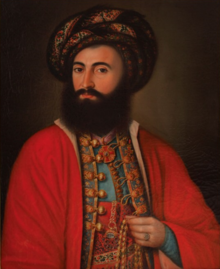Our website is made possible by displaying online advertisements to our visitors.
Please consider supporting us by disabling your ad blocker.
Constantin Cantacuzino (died 1877)
| Constantin G. Cantacuzino | |
|---|---|
 Cantacuzino with the Order of Saint Anna, ca. 1820; portrait attributed to Pavel Đurković | |
| Caimacam (Regent of Wallachia) | |
| Reign | September 22, 1848 – June 1849 |
| Predecessor | Princely Lieutenancy (Christian Tell, Ion Heliade Rădulescu, Nicolae Golescu) |
| Successor | Barbu Dimitrie Știrbei (as Prince) |
| Born | between 1791 and 1800 |
| Died | 1877 (aged 76–86) |
| Burial | Saint John the Great Church, Bucharest Bellu cemetery (reburial) |
| Spouse | Zoe Slătineanu (m. ca. 1822; d. 1839) |
| Issue | Ion C. Cantacuzino Grigore Cantacuzino Adolf Cantacuzino Alexandra (Alexandrina) Manu |
| House | Cantacuzino |
| Father | Gheorghe (Iordache) Cantacuzino |
| Mother | Maricuța Pârșcoveanca |
| Religion | Orthodox |
Constantin G. Cantacuzino, also known as Costache Cantacozino or Costandin Cantacuzino (transitional Cyrillic: Кonстanтin Кanтaкozino; 1790s–1877), was the Caimacam (Regent) of Wallachia in September 1848–June 1849, appointed directly by the Ottoman Empire. A member of the Cantacuzino family, he had emerged as a leader of the conservative boyardom during the Regulamentul Organic period. As a commander in the Wallachian militia, he organized in 1831 the first elections for Bucharest's Town Council, and subsequently served as one of the Bucharest Governors. He first played a major part in national government from 1837 to 1842, when he served Prince Alexandru II Ghica as Postelnic and Logothete. During that interval, he clashed with his own brother Grigore Cantacuzino, who sided with the liberal current.
Falling out of favor with the Russian Empire, Cantacuzino was deposed ahead of Ghica himself, and was an unsuccessful candidate in the princely election of December 1842. After years in self-imposed exile, Cantacuzino returned with the Ottoman Army in September 1848, helping to quell the 1848 Revolution—although his own son, Ion C. Cantacuzino, had been active within the revolutionary movement. Supervised by Fuad Pasha, Constantin sent the revolutionary leadership, including his immediate predecessors, into exile. He then oversaw the imprisonment and mistreatment of various others, being allegedly responsible for the death in custody of writer Ion Catina. He also disarmed the rebel forces, while restoring both Regulamentul and its symbols of power, as well as reintroducing slavery.
Cantacuzino resigned when Barbu Dimitrie Știrbei took over as Prince, but remained active within Știrbei's successive governments, being granted the office of Great Vornic. He opposed the Prince's views on agrarian reform, taking an ultra-conservative stance which favored indentured servitude for Wallachian farmers. Throughout the early 1850s, Cantacuzino actively sought the crown of Wallachia for himself, championing Ottoman loyalism. His in-law Nicolae Mavros also attempted to make him ruler of both Danubian Principalities.
Cantacuzino's final moment in power was in late July 1854, during an interregnum caused by the Crimean War. He became the president of an Administrative Council created by Mikhail Dmitrievich Gorchakov just before the Russian withdrawal from Wallachia. The Ottomans then recognized him as head of a caretaker government, jointly with Constantin Năsturel-Herescu, although both resigned after Știrbei's second return that September. After rallying with a larger conservative coalition, he served a final ministerial term in 1856, became a minor contender in the princely election of 1859, and was Vice President of the resulting Ad hoc Divan. In this capacity, he streamlined the election of Alexandru Ioan Cuza as Domnitor. While the Caimacam spent the remainder of his life abroad, his sons Ion and Adolf remained active in the administration of the United Principalities. Constantin was the father-in-law of General Gheorghe Manu, as well as the grandfather of microbiologist Ioan Cantacuzino and of poet Scarlat Cantacuzino.
Previous Page Next Page


